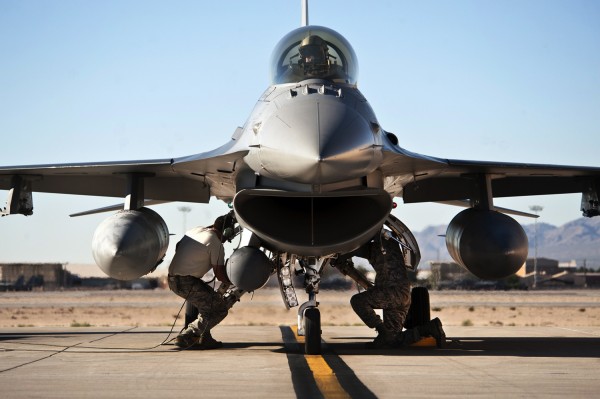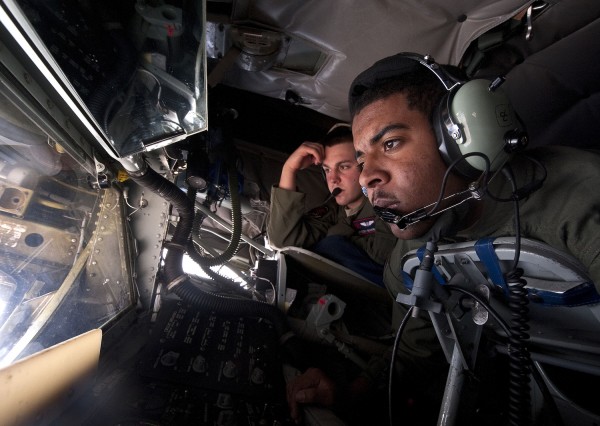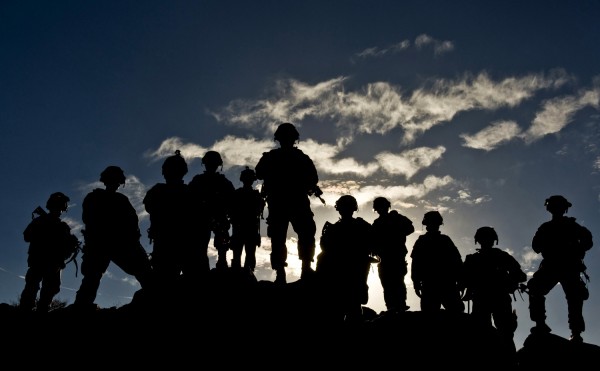
Two F-16 Fighting Falcons assigned to the Alabama Air National Guard’s 187th Fighter Wing approach a tanker during an aerial refueling mission over Nevada during exercise Green Flag-West 13-02. (U.S. Air Force photo/Staff Sgt. Christopher Hubenthal)
CLICK HERE TO VIEW PHOTO GALLERY
About 75,000 joint, coalition and U.S. military members receive critical training in Green Flag exercises each year through about 3,000 sorties that use more than 700,000 pounds of live and training ordinance.
At Nellis Air Force Base, Nev., Green Flag-West 13-2 provided combat training to warfighters in air-land integration and joint employment of airpower. The exercise enabled Airmen to train in a joint and coalition exercise to prepare to operate in an ever-changing battlefield.
The exercise trains joint and coalition warfighters to operate in future contested and degraded air-land environments, over the Leech Lake Training Range and at the National Training Center located at Fort Irwin, Calif.

Two dedicated crew chiefs with the 187th FW perform post-flight inspections on an F-16 prior to the aircraft shutdown after a Green Flag-West 13-02 mission at Nellis Air Force Base, Nev. (U.S. Air Force photo/Lawrence Crespo)
“The U.S. Army is shifting to decisive action rotations, involving mechanized and armored brigades, so now it is much more robust,” said Lt. Col. Mark Wisher, the 549th Combat Training Squadron commander. “It is kind of a tank battle (at the NTC) now. As they shift their tactics to fight that kind of fight, it requires a different shift in our air power perspective as well.”
The training is designed to instill core skill sets that many Airmen today may have never encountered.
“In past conflicts, we’ve been executing predominately low-threat close air support in Southwest Asia.” Wisher said. “So essentially, aircraft carrying bombs owned the skies with joint terminal air controllers calling in air strikes where threats were small arms, man-portable air-defense systems, and rocket-propelled grenades. That is a pretty permissive environment where we can operate kind of like a hawk and pick off targets as we see fit. That environment is changing.”
Airmen of the 12th CTS stationed at Fort Irwin work closely with the 549th CTS to train Airmen to work with Soldiers to make combatting a comparable adversary more effective. Tactical air control party Airmen of the 13th Air Support Operations Squadron are embedded with Army battalions to help request close air support through a JTAC that is trained to provide air strike requests.

Airman 1st Class Adrian Snelson (right) waits to refuel an aircraft over Nevada as Staff Sgt. Cody Beverly evaluates during the Green Flag-West 13-02 exercise. Snelson and Beverly are boom operators assigned to McConnell Air Force Base, Kan. (U.S. Air Force photo/Staff Sgt. Christopher Hubenthal)
“One of the beauties of close air support is there is a standardized way of doing it,” Wisher said. “It doesn’t matter who the pilot is, it doesn’t matter who the JTAC is, it doesn’t matter what uniform they wear, they are going to go out there and are going to execute it the same, which is critical.”
While Soldiers of the 1st Brigade, 4th Infantry Division conducted operations on the ground at the NTC, the Air Force offered TACP support as well as close air support from the 34th Bomb Squadron from Ellsworth AFB, S.D.; the 963rd Airborne Air Control Squadron from Tinker AFB, Okla.; the 22nd Air Refueling Wing from McConnell AFB, Kan.; and the 100th Fighter Squadron from the Alabama Air National Guard, operating out of Nellis AFB.
“This is very beneficial to us,” said Chief Master Sgt. Johnny Tadlock, the 100th Fighter Squadron aircraft maintenance superintendent. “It gets the Airmen’s thought process going right. We’re loading live bombs out here so they have to take more time and actually having that yellow and brown stripe around that bomb makes it hit home.”
For Tadlock, the various locations offer an ideal scenario for training.

Soldiers watch troop movements during exercise Green Flag-West 13-02 at the National Training Center at Fort Irwin, Calif. They are assigned to the 1st Brigade at Fort Carson, Colo. (U.S. Air Force photo/Senior Airman Daniel Hughes)
“Green Flag is the best training you can get because you are dropping live bombs,” Tadlock said. “You have to drop bombs on the target, you have to get it done by a certain time and as far as maintenance goes that just means our practices have to be perfect and loaded flawlessly every time. Nellis AFB is outstanding. There is no place in the world like it. You can never replace what the Airmen do out here.”
From the ground to the air, incorporated in a joint and coalition environment, the Green Flag-West exercise is adapted to help provide the best training possible to combat an ever changing adversary.
“Every rotation, we’re having Airmen and Soldiers work side by side to go out there and execute,” Wisher said. “When we go into combat, it won’t be the Air Force going alone, it will be a joint and sometimes coalition operation. It’s great that we can incorporate that aspect into every exercise.”
